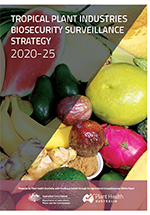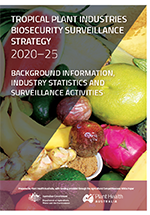Read the latest information on
Foot-and-mouth disease
 Hot on the heels of the release of the surveillance guide for pests of tropical horticulture last month, the Tropical Plant Industries Biosecurity Surveillance Strategy 2020–25 is now also available.
Hot on the heels of the release of the surveillance guide for pests of tropical horticulture last month, the Tropical Plant Industries Biosecurity Surveillance Strategy 2020–25 is now also available.
The surveillance strategy is the latest resource prepared by Plant Health Australia (PHA) to improve biosecurity surveillance in northern Australia to protect growers from the costly impacts of pests and diseases and to realise the full potential of production systems in the north.
Following a series of workshops, meetings and discussions with numerous stakeholders, the strategy was developed by industries, the Australian Government and the governments of Western Australia (WA), Northern Territory (NT) and Queensland. It paints a picture of the many industries active in the north and highlights what we risk losing, or impeding the development of, if exotic pests and diseases were to enter and become established in the growing regions of northern Australia.
Plant Health Australia’s Biosecurity Planning Manager, Trevor Dunmall, who helped develop the strategy, said that the unique features of northern Australia’s growing regions present unique challenges to effective surveillance.
“Northern Australia has a diverse range of plants, a sparse population, an extensive coastline and isolated growing regions. It’s also close to neighbouring countries with high exotic pest populations. These combine to create specific biosecurity challenges,” said Trevor.
There’s a wide range of crops grown across northern Australia including sugar, cotton, avocados, bananas, citrus, mangoes, lychees, melons, production nurseries, papaya, passionfruit, pineapples, vegetables and exotic tropical fruits and the strategy is relevant to all of them.
The size and nature of the production enterprises vary greatly, and differences in their location, production methods, markets and exposure to key exotic pest threats means that all industries have a varying biosecurity focus, capability and capacity.
“Competing priorities and limited resources in government and industry also need to be considered when developing a strategy to improve surveillance,” said Trevor.
“The strategy looks at the ways in which pests can enter and spread in the north, and the role that different types of surveillance and monitoring can be used to manage biosecurity threats.”
One of the most obvious strategies is to prevent the entry of the pests. However, this is not always possible, and activities like enhanced surveillance, effective preparedness activities and improved pest management are also needed.
Goal 1: Improve planning, prioritisation, preparedness and coordination for surveillance
Goal 2: Increase effective engagement, awareness and communication within and between stakeholders
Goal 3: Improve surveillance delivery
Goal 4: Ensure availability of future diagnostic services
Goal 5: Improve surveillance data capture, quality and access for stakeholders
 In addition to the strategy there’s also a background document that provides industry statistics and describes surveillance activities that are currently being undertaken by industries in the north by the Australian Government, and the governments of WA, NT and Queensland.
In addition to the strategy there’s also a background document that provides industry statistics and describes surveillance activities that are currently being undertaken by industries in the north by the Australian Government, and the governments of WA, NT and Queensland.
Implementation of the strategy has commenced and is being guided by a steering committee comprising representatives of seven key industry groups, the three northern governments and the Australian Government. The steering committee is chaired by Greg Owens from NT Farmers.
The strategy and backgrounder are available on the Plant Health Australia website planthealthaustralia.com.au/strategies